


Wales
1980-2000
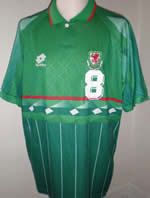 The decade began with Wales beating England 4-1 at Y Cae Raes in Wrexham. The team almost qualified for the 1982 FIFA World Cup finals but a 0-3 defeat by the Soviet Union in their final qualifier meant they missed out on goal difference. They came even closer to qualifying for USA '94: needing to beat Romania at home in their final qualifier, they missed a penalty with the scores at 1-1 and the visitors went on to win 2-1. The popular manager and former player, Terry Yorath was dismissed after this defeat and replaced by John Toshack, another former Welsh international. Toshack was booed off the pitch by Welsh supporters after his first match in charge (a 1-3 defeat against Norway) and promptly resigned. Bobby Gould was appointed manager in 1995 but his questionable tactics and inability to manage his top players led to one of the darkest periods in Welsh football history, which included a 1-7 hammering by the Dutch in 1996.
The decade began with Wales beating England 4-1 at Y Cae Raes in Wrexham. The team almost qualified for the 1982 FIFA World Cup finals but a 0-3 defeat by the Soviet Union in their final qualifier meant they missed out on goal difference. They came even closer to qualifying for USA '94: needing to beat Romania at home in their final qualifier, they missed a penalty with the scores at 1-1 and the visitors went on to win 2-1. The popular manager and former player, Terry Yorath was dismissed after this defeat and replaced by John Toshack, another former Welsh international. Toshack was booed off the pitch by Welsh supporters after his first match in charge (a 1-3 defeat against Norway) and promptly resigned. Bobby Gould was appointed manager in 1995 but his questionable tactics and inability to manage his top players led to one of the darkest periods in Welsh football history, which included a 1-7 hammering by the Dutch in 1996.
From 1989, home matches were played at the National Stadium in Cardiff (sometimes incorrectly called Cardiff Arms Park, which was in fact next door) until this was demolished in 1997 to make way for the Millennium Stadium.
Sources:
 1980-1987
1980-1987
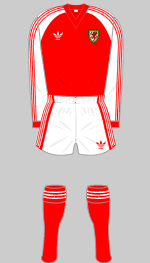
1980-1984
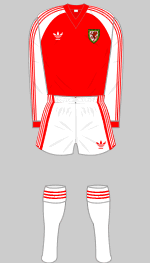
1982-1984 alt
v Scotland
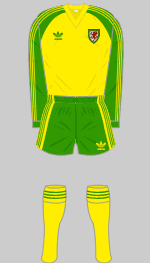
1980-1984 Change
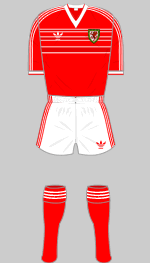
1984-1987
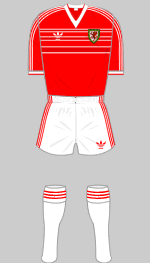
1985-1986 alt
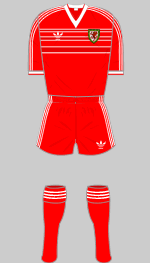
March 1986 v Ireland
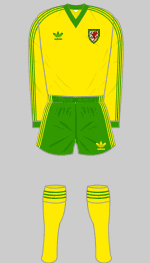
1984-1987 Change
Designer: Adidas
In 1979 Admiral fell into financial difficulties and the FAW engaged Adidas as their kit supplier for the next seven years. The new home shirt featured white sleeves for the first time but was otherwise a standard Adidas template of the period. The away kit was made using the same design but in the usual yellow and green. The home set was retained for four years before an updated version was introduced, which dropped the white sleeves and added horizontal shadow bands edged in white. White socks were worn against Scotland (home and away), Spain and Uruguay while an all-red version was used against Ireland. Curiously Adidas did not produce an equivalent version as a change kit, which used the classic Adidas template instead.
Players were provided with both long and short sleeved versions, choosing whichever they preferred for each match. This became standard practice.
 1987-1990
1987-1990
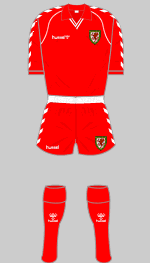
1987-1990
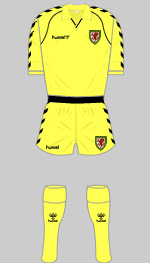
1987-1990 Change
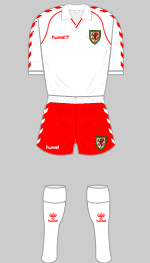
Sept 1988 v Netherlands
Designer: Hummel
The FAW turned to the Danish sportswear manufacturer, Hummel, whose radical designs were popular in Scandinavia and with several Football League clubs. The new home kit marked a return to all-red, trimmed with Hummel's distinctive chevrons in white. The away kit was identical but in pale yellow and trimmed in black rather than the more familiar green. Hummel produced a white set of shirts and socks for their match with the Netherlands in 1988, the only time this appeared.
 1990-1992
1990-1992
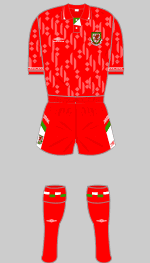
1990-1992
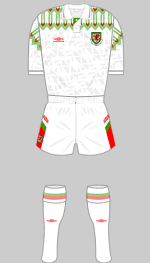
1990-1992 Change
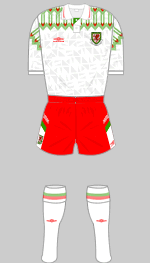
Nov 90 v Luxembourg
Designer: Umbro
After an absence of 16 years, Umbro returned as Wales' kit partner at a time when designs were becoming ever more outlandish, due largely to the growth in replica sales. Shirts were designed with an eye for how they would look worn with jeans on the High Street as much their appearance on the pitch. Umbro's first home kit was a relatively restrained affair, which kept the popular all-red look with some discrete trimmings in green and white. The shirt was manufactured from "copa mondial" shadow fabric, which was also used for England's blue third strip of the period.
The away kit was an altogether more adventurous business. Basically white, the shirt featured a complicated pattern in green and red over an abstract shadow fabric. The shorts and stockings were identical in design to those of the home set, allowing elements to be mixed and matched if required.
The traditional FAW motto Gorau Chwarae Cyd Chwarae (Best Play, Play Together) was restored to a scroll below the crest.
 1992-1994
1992-1994
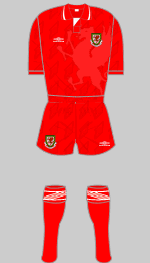
1992-1994
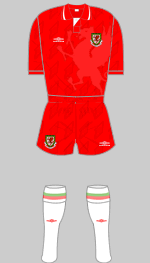
May 1992 v Romania
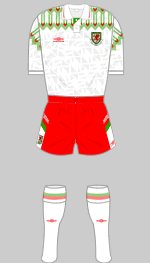
May 92 v Netherlands
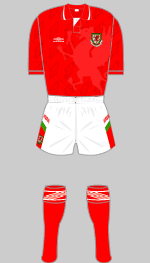
June 1992 v Japan
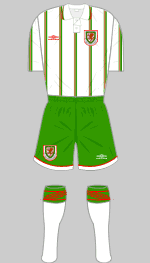
1993-1994 Change
Designer: Umbro
Umbro's practice was to change one kit every season to maximise replica sales so the all-white change kit was retained for an extra year to establish the rotation. The new all-red home kit had stylised Umbro logos woven into the fabric (the company had no compunction about finding creative ways to get round the rules on kit sponsorship by using their branding as part of the design). The Welsh dragon appeared as a large watermark on the shirts.
The new change kit was introduced in 1992 but was not used until the following year, with extraordinary green candy stripes, each of which incorporated red and white pinstripes, a detail that was invisible from a distance. Green shorts were introduced for the first time.
 1994-1996
1994-1996
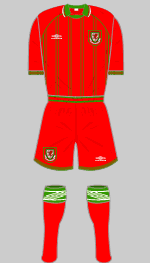
1994-1996

1994 Change
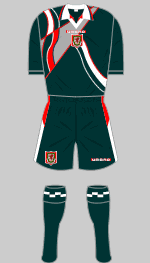
1995-1996 Change
Designer: Umbro
Green was restored to the home kit in the form of a host of trimmings, including Umbro logos combined into strips at the cuffs and thigh. Red and green do not really work well together without a third colour to provide some contrast and this kit cannot be considered one of Umbro's better efforts. An extravagant change kit was unveiled in August 1994. Based on a dark blue/green, the shirt was adorned with a swirling motif that owed more to abstract art than anything connected with Wales' football heritage.
It was the fashion of the period to place crests on an additional shield and this was the case with the FAW badge.
 1996-1998
1996-1998
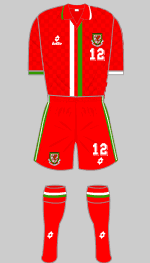
1996-1998
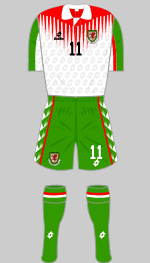
1996-1998 Change
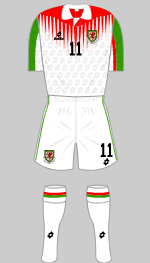
Oct 1997 v Belgium
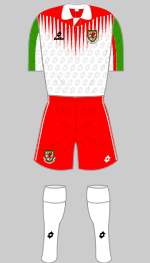
March 1998 v Jamaica
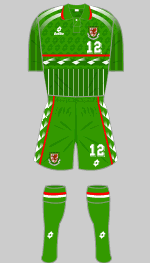
1996-1997 Third
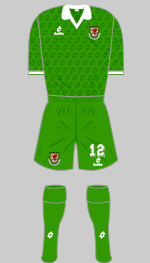
1998 Third
Designer: Lotto
Under the management of Bobby Gould, Wales' results were depressing but at least their kits were lively. The Italian company Lotto were appointed as Wales' kit suppliers and started off with a fine all-red home strip that featured one green and one white vertical strip. This popular shirt also featured asymmetrical trimmings to collar and cuff. Squad numbers now appeared on the front of players' shirts and were placed, rather unconventionally, below the FAW crest.
The Italian designers let their imaginations rip for the complementary change and third strips, the latter resembling a leisure top more than a football shirt. This design was retired after only one year and replaced by a plain green strip that was used only twice, in an end of season tour of the Mediterranean. A 3-0 win over Malta was followed by 0-4 rout in Tunisia: green has not been used as a dominant colour since then.
 1998-2000
1998-2000
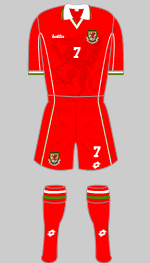
1998-2000
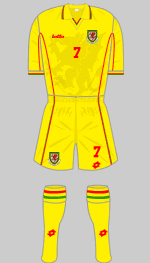
1998-2000 Change
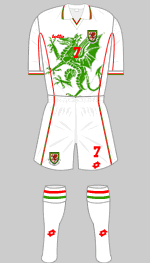
1998-2000 Third
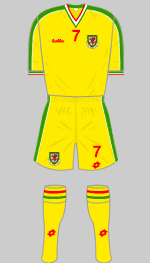
10 October 1998 v Denmark
Designer: Lotto
Lotto's new designs for 1998 were a stunning trio of complementary outfits, in red, yellow and white. Y Ddraig Goch (the red dragon of Wales) was woven into the home and change kits as a watermark but on the white set, it was rendered in green. The yellow change strip was worn just once, a 0-2 defeat in Switzerland on 31 March 1999, as was the white version, which was brought out when Wales played Qatar in Doha in February 2000.
The strip worn when Wales beat Denmark in Copenhagen 2-1 in a European qualifier is a complete mystery, as it was worn only a month after the new suite was launched. It is possible that Lotto had failed to deliver the yellow set in time for the game and supplied a set from stock instead.
The much delayed resignation of Bobby Gould in 1999 was broadly welcomed throughout Wales and the popular Mark Hughes was appointed to take his place.
<Wales 1964-1979 :
Home Internationals Index Page :
Wales 2000-2010>



 The decade began with Wales beating England 4-1 at Y Cae Raes in Wrexham. The team almost qualified for the 1982 FIFA World Cup finals but a 0-3 defeat by the Soviet Union in their final qualifier meant they missed out on goal difference. They came even closer to qualifying for USA '94: needing to beat Romania at home in their final qualifier, they missed a penalty with the scores at 1-1 and the visitors went on to win 2-1. The popular manager and former player, Terry Yorath was dismissed after this defeat and replaced by John Toshack, another former Welsh international. Toshack was booed off the pitch by Welsh supporters after his first match in charge (a 1-3 defeat against Norway) and promptly resigned. Bobby Gould was appointed manager in 1995 but his questionable tactics and inability to manage his top players led to one of the darkest periods in Welsh football history, which included a 1-7 hammering by the Dutch in 1996.
The decade began with Wales beating England 4-1 at Y Cae Raes in Wrexham. The team almost qualified for the 1982 FIFA World Cup finals but a 0-3 defeat by the Soviet Union in their final qualifier meant they missed out on goal difference. They came even closer to qualifying for USA '94: needing to beat Romania at home in their final qualifier, they missed a penalty with the scores at 1-1 and the visitors went on to win 2-1. The popular manager and former player, Terry Yorath was dismissed after this defeat and replaced by John Toshack, another former Welsh international. Toshack was booed off the pitch by Welsh supporters after his first match in charge (a 1-3 defeat against Norway) and promptly resigned. Bobby Gould was appointed manager in 1995 but his questionable tactics and inability to manage his top players led to one of the darkest periods in Welsh football history, which included a 1-7 hammering by the Dutch in 1996.




























